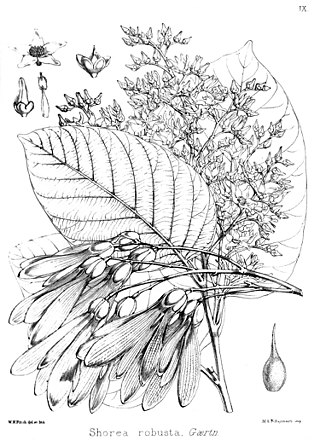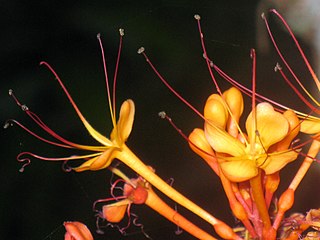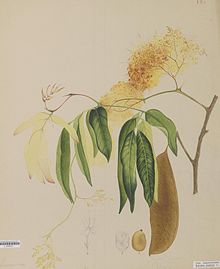
Ashoka, popularly known as Ashoka the Great, was the third Mauryan Emperor of Magadha in the Indian subcontinent during c. 268 to 232 BCE. His empire covered the largest part of the Indian subcontinent, stretching from present-day Afghanistan in the west to present-day Bangladesh in the east, with its capital at Pataliputra. A patron of Buddhism, he is credited with playing an important role in the spread of Buddhism across ancient Asia.

Azadirachta indica, commonly known as neem, margosa, nimtree or Indian lilac, is a tree in the mahogany family Meliaceae. It is one of two species in the genus Azadirachta. It is native to the Indian subcontinent and to parts of Southeast Asia, but is naturalized and grown around the world in tropical and subtropical areas. Its fruits and seeds are the source of neem oil. Nim is a Hindustani noun derived from Sanskrit nimba (निंब).

A mango is an edible stone fruit produced by the tropical tree Mangifera indica. It originated from the region between northwestern Myanmar, Bangladesh, and northeastern India. M. indica has been cultivated in South and Southeast Asia since ancient times resulting in two types of modern mango cultivars: the "Indian type" and the "Southeast Asian type". Other species in the genus Mangifera also produce edible fruits that are also called "mangoes", the majority of which are found in the Malesian ecoregion.

Tamarind is a leguminous tree bearing edible fruit that is indigenous to tropical Africa and naturalized in Asia. The genus Tamarindus is monotypic, meaning that it contains only this species. It belongs to the family Fabaceae.

Lagerstroemia, commonly known as crape myrtle, is a genus of around 50 species of deciduous and evergreen trees and shrubs native to the Indian subcontinent, southeast Asia, northern Australia, and other parts of Oceania, cultivated in warmer climates around the world. It is a member of the family Lythraceae, which is also known as the loosestrife family. The genus is named after Swedish merchant Magnus von Lagerström, a director of the Swedish East India Company, who supplied Carl Linnaeus with plants he collected. These flowering trees are beautifully colored and are often planted both privately and commercially as ornamentals.

Saraca asoca, commonly known as the ashoka tree, is a plant belonging to the Detarioideae subfamily of the legume family. It is an important tree in the cultural traditions of the Indian subcontinent and adjacent areas. It is sometimes incorrectly known as Saraca indica. The flower of Ashoka tree is the state flower of Indian state of Odisha.

The curry tree or Bergera koenigii, is a tropical and sub-tropical tree in the family Rutaceae, native to Asia. The plant is also sometimes called sweet neem, though M. koenigii is in a different family to neem, Azadirachta indica, which is in the related family Meliaceae.

Shorea robusta, the sal tree, sāla, shala, sakhua, or sarai, is a species of tree in the family Dipterocarpaceae. The tree is native to India, Bangladesh, Nepal, Tibet and across the Himalayan regions.

Cassia fistula, also known as golden shower, purging cassia, Indian laburnum, Kani Konna ,, Konna Poo or pudding-pipe tree, is a flowering plant in the family Fabaceae. The species is native to the Indian subcontinent and adjacent regions of Southeast Asia. It is the official state flower of Kerala state in India. It is also a popular ornamental plant and is also used in herbal medicine.

Manilkara zapota, commonly known as sapodilla, sapote, chicozapote, chicoo, chicle, naseberry, nispero, or soapapple, among other names, is an evergreen tree native to southern Mexico and Central America. An example natural occurrence is in coastal Yucatán, in the Petenes mangroves ecoregion, where it is a subdominant plant species. It was introduced to the Philippines during Spanish colonization. It is grown in large quantities in Mexico and in tropical Asia, including India, Pakistan, Thailand, Malaysia, Cambodia, Indonesia, Vietnam, Bangladesh, as well as in the Caribbean.

Saraca L. is a genus of flowering plants in the family Fabaceae of about 20 plant species of trees native to the lands from India and Sri Lanka to Indochina, southern China Malesia, and New Guinea.

Monoon longifolium, the false ashoka, also commonly known by its synonym Polyalthia longifolia, is an Asian small tree species in the family Annonaceae. It is native to southern India and Sri Lanka, but has been widely introduced elsewhere in tropical Asia. This evergreen tree is known to grow over 20 m. in height and is commonly planted due to its effectiveness in alleviating noise pollution. It exhibits symmetrical pyramidal growth with willowy weeping pendulous branches and long narrow lanceolate leaves with undulate margins.

Vateria indica, the white dammar, is a species of tree in the family Dipterocarpaceae. It is endemic to the Western Ghats mountains in India. It is threatened by habitat loss. It is a large canopy or emergent tree frequent in tropical wet evergreen forests of the low and mid-elevations.

Mangifera indica, commonly known as mango, is a species of flowering plant in the family Anacardiaceae. It is a large fruit tree, capable of growing to a height of 30 metres. There are two distinct genetic populations in modern mangoes – the "Indian type" and the "Southeast Asian type".

Flacourtia indica (known commonly as ramontchi, governor's plum and Indian plum, is a species of flowering plant native to much of Africa and tropical and temperate parts of Asia. It has various uses, including folk medicine, fuel, animal food and human food.
Ashoka tree is a common name for two plants which are frequently confused with each other:
The Ch. Devi Lal Rudraksh Vatika Herbal Nature Park, in short Rudraksh Vatika, is a 184 acre forested wildlife area, wetland and herbal park for the conservation of biodiversity of over 400 endangered ayurvedic medicinal herbs in Shivalik foothills of Himalayas. It is located on the western bank of Western Yamuna Canal, 1.3 km east of NH-907, in Chuharpur Kalan village of Yamunanagar district of Haryana state in India.

The 48 kos parikrama is a parikrama of various Mahabharata-related and other Vedic-era tirthas around the holy city of Kurukshetra in the state of Haryana, India.

The sacred groves is a zone of Biodiversity Park, Visakhapatnam located in the premises of Rani Chandramani Devi Government Hospital. It has more than 100 sacred plant species, which are medicinal herbs with religious importance. Many sacred plants are becoming rare and endangered. Hence they are to be reared, protected, and conserved. The zone was inaugurated on February 5, 2017, by Kambhampati Hari Babu, a member of parliament from Visakhapatnam, Andhra Pradesh.


















